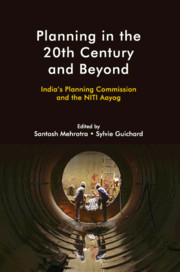Book contents
- Frontmatter
- Contents
- List of Figures
- List of Tables
- List of Abbreviations
- 1 Planning for a 21st Century India
- Part I Origins: Ideas and Ideology
- 2 From Economists to Historians: Studying the Planning Commission, 1950–2014
- 3 The Long Road to Indian Economic Planning (until 1950)
- 4 Ideas and Origins of the Planning Commission in India
- Part II Changes and Continuity: Development and Adaptation of Planning and the Planning Commission
- 5 The Planning Commission and Education
- 6 Addressing Agrarian Distress: Sops versus Development
- 7 Economic Planning after Economic Liberalization: Between Planning Commission and Think Tank NITI, 1991–2015
- 8 Planning Commission: Obiter Dictum
- 9 On a Revived Planning Commission
- Part III Planning Beyond the Planning Commission
- 10 Make in India
- 11 Manufacturing: The Cornerstone of a Planning Strategy for the 21st Century
- 12 Fiscal Planning to Sustain Growth and Poverty Reduction
- 13 Plan, but Do Not Over-plan: Lessons for NITI Aayog
- 14 Why Does India Need a Central Planning Institution in the 21st Century?
- Notes on Contributors
- Index
- References
11 - Manufacturing: The Cornerstone of a Planning Strategy for the 21st Century
Published online by Cambridge University Press: 04 April 2020
- Frontmatter
- Contents
- List of Figures
- List of Tables
- List of Abbreviations
- 1 Planning for a 21st Century India
- Part I Origins: Ideas and Ideology
- 2 From Economists to Historians: Studying the Planning Commission, 1950–2014
- 3 The Long Road to Indian Economic Planning (until 1950)
- 4 Ideas and Origins of the Planning Commission in India
- Part II Changes and Continuity: Development and Adaptation of Planning and the Planning Commission
- 5 The Planning Commission and Education
- 6 Addressing Agrarian Distress: Sops versus Development
- 7 Economic Planning after Economic Liberalization: Between Planning Commission and Think Tank NITI, 1991–2015
- 8 Planning Commission: Obiter Dictum
- 9 On a Revived Planning Commission
- Part III Planning Beyond the Planning Commission
- 10 Make in India
- 11 Manufacturing: The Cornerstone of a Planning Strategy for the 21st Century
- 12 Fiscal Planning to Sustain Growth and Poverty Reduction
- 13 Plan, but Do Not Over-plan: Lessons for NITI Aayog
- 14 Why Does India Need a Central Planning Institution in the 21st Century?
- Notes on Contributors
- Index
- References
Summary
Although India's gross domestic product (GDP) growth rate since independence has consistently increased decade by decade, industry (including manufacturing, construction, and so on) accounts for only 25 per cent of GDP (in 1950, it was 8 per cent). The manufacturing sector contributed in 2017 only about 16 per cent in the GDP, stagnating since economic reforms began in 1991. By contrast, in some Asian economies, the share of industry has exceeded 30–40 per cent while that of manufacturing, 20–30 per cent. For example, Malaysia roughly tripled its share of manufacturing value-added in GDP from 1960 to 2014 to reach about 24 per cent, while Thailand's share increased from 13 per cent to 33 per cent over the same period (Mitra et al. 2017); Vietnam too has seen a sharp increase in recent decades. In India, manufacturing has never been the leading sector in the economy other than during the second and third plan periods, and certainly not since the economic reforms.
No major country in the world has managed to reduce poverty or sustain growth over long periods of time without the manufacturing sector becoming the lead sector, driving economic growth. This is because productivity levels in industry (and manufacturing) are much higher than in either agriculture or services, and it has historically proved to be the source of productivity gains across the primary and tertiary sectors, through the spread effects of technological change. Manufacturing is an engine of economic growth because in addition to higher productivity, the manufacturing sector offers greater opportunities for economies of scale, for embodying technological progress and generates forward and backward linkages that create positive spillover effects in the economy. The growth in services after manufacturing growth is very different in nature – it is in research and development (R&D) and high-end services – while without manufacturing, they are in low-end and fragile services. This is because manufacturing provides a strong technological base in the country. Not surprising that Rodrik (2011) has demonstrated that countries with larger manufacturing sectors grow faster.
Almost all organized sector industries saw accelerated growth of output and employment from 1991–1992 to 1995–1996 (with minerals and metals, machinery, automobiles, and chemicals and petrochemicals out-performing). However, this growth of organized manufacturing decelerated between 1996–1997 and 2001–2002.
- Type
- Chapter
- Information
- Planning in the 20th Century and BeyondIndia's Planning Commission and the NITI Aayog, pp. 208 - 243Publisher: Cambridge University PressPrint publication year: 2020
References
- 1
- Cited by



